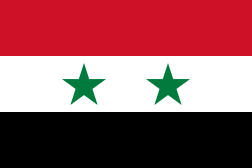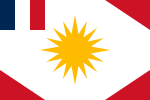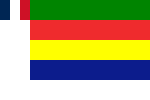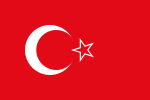シリアの国旗の変遷を見ていると シリアの民族や文化、政治の変遷を物語っていることに気づく。また判り易い。それぞれのシンボルに表れる願い。希望と勇気、愛情と情熱。一度 ざっと眺めてみよう。また補完的に 地図の変遷を見ると 良く判る。
★シリアと周辺国の 歴史の解説のYoutubeを幾つか見てみよう。シリアの現状が どのようにして、もたらされたのか?
が 良く判る。
シリア・アサド大統領、単独インタビュー(全録)
 |
|
|---|---|
| 用途及び属性 | |
| 縦横比 | 2:3 |
| 制定日 | 1980年 |
| 使用色 | |
シリアの国旗は、1980年に制定された。この国旗のデザインは、1958年から1961年の間も使われていた。
シリア国旗の変遷
★ アラビア語だが 眺めていると アラビアのロレンスが出てきたり サウジアラビアの初代国王が出てきたり 色々類推すると
勉強になる。 こういうことを経て 現在のシリアになっている。エジプトのナセル大統領 アサド初代大統領。
様々な事件や戦争があったことが判る。こんな国旗まであったのか?と驚く。
シリアという国はあったのか(1) 紀元前を見る
_______________________________________________
最初のシリア国旗は、ハーシム家が建てたシリア王国時代の1920年にデザインされた。これは現在のヨルダンの国旗に似ているが緑色と白色の順序が逆で、第一次世界大戦中にハーシム家が率いたアラブ反乱の旗をもとに七つの角のある白い星を加えたものであり、アラブ世界で最初に汎アラブ色を取り入れた国旗だった。しかしシリアはフランスの委任統治となったためフランス軍はシリアへ侵攻、ハーシム家は敗れ、王家はイギリスの手によりイラク王国の国王に据えられた。フランス委任統治領シリアは王国の旗に替え、青地に白の三日月、左隅(カントン)にフランスの国旗を配した旗を制定した。さらに一ヵ月後、緑・白・緑の水平三色旗に、左隅にフランス国旗を配した旗に代えられた。この旗は1925年から1932年まで使用された。同時期シリアはアラウィー派国やドゥルーズ派国などにも分割されており、それぞれ左隅にフランス国旗を配した旗を制定した。
この旗は1932年に、上から緑・白・黒の三色の帯があり、白帯のところに3つの赤い星(五芒星)があるデザインに代えられ、次いでフランス・シリア条約が制定されシリアは部分的な独立を得た。緑はイスラム帝国初期の正統カリフの時代を、白はウマイヤ朝を、黒はアッバース朝を表していた。三つの赤い五芒星は当初は委任統治領シリアのアレッポ地区、ダマスカス地区、デリゾール地区を指していたが、1936年にアラウィー派国とドゥルーズ派国がシリアに合流すると、三つの星はシリアの主要部、アラウィ―派地域、ドゥルーズ派地域を表すということになった。1944年の独立時もこの旗であった。
1958年にシリアとエジプトがアラブ連合共和国を結成した時に、赤・白・黒で緑の星が二つある現在と同じデザインのものが使われた(二つの星はエジプトとシリアを意味する)。1961年にアラブ連合共和国を離脱した際に、古いデザインに戻ったが、1963年にバアス党のクーデターでまた赤・白・黒の水平三色旗に戻った。この時には星は3つとなった(同時期にバアス党が政権を奪取したイラクの国旗と同様のデザインであり、当初はイラク・シリア・エジプトによる汎アラブ国家建設の構想もあったとされるが、実現しなかった)。
1971年、リビアのカダフィ大佐主導で、シリア・エジプト・リビアの汎アラブ主義国がアラブ共和国連邦を結成し国旗を統合した。この連邦は、赤・白・黒の水平三色旗の中央にアラビア語で「アラブ共和国連邦」と書かれた巻物を持つ金の鷹の旗を国旗に制定したが、この連邦は政治統合を見ないまま1977年に解消した。
1980年より現在のデザインが使われるようになった。この旗はアラブ連合共和国当時と同じデザインで、赤色もアラブ共和国連邦当時の赤色からアラブ連合当時のやや明るい赤色に戻された。
2011年から始まったシリア騒乱では、バッシャール・アル=アサド率いるバアス党政権に反対する勢力が、アサド政権とバアス党の正当性を否定するため、バアス党の政権掌握以前に制定された1932年時の国旗を「シリア革命旗」として使用している。
-
 ?シリア王国の国旗 (1920)
?シリア王国の国旗 (1920) -
 ?フランス委任統治領シリアの旗 (1920-1922)
?フランス委任統治領シリアの旗 (1920-1922) -
 ?フランス委任統治領シリアの旗 (1922-1932)
?フランス委任統治領シリアの旗 (1922-1932) -
 ?1932年から1958年、および1961年から1963年にかけて用いられた旗
?1932年から1958年、および1961年から1963年にかけて用いられた旗 -
 ?アラブ共和国連邦の軍艦旗
?アラブ共和国連邦の軍艦旗 -
 ?アラブ共和国連邦時代の大統領旗
?アラブ共和国連邦時代の大統領旗
汎アラブ色
国旗に使われている色は伝統的な汎アラブ色であり、イエメン、エジプト、スーダン、イラクとも共通する。二つの星はアラブ連合当時の二つの地域(シリアとエジプト)を象徴している。緑は正統カリフまたはファーティマ朝を、白はウマイヤ朝を、黒はアッバース朝を、赤は殉教者を表すとされるが、赤はヒジャーズのハーシム家を表すという見方もある。
【武田邦彦】シリアがフランスから独立したのは〇〇のおかげ!!
 武田邦彦 神ちゃんねる 2017/03/26 に公開
武田邦彦 神ちゃんねる 2017/03/26 に公開__________________________________________________________________________________
【必聴】 シリアの悲劇 / 武田邦彦ブログ音声 #武田邦彦 #武田教授
Flag of Syria
As a result of the ongoing Syrian civil war, there are currently two governments claiming to be the de jure government of Syria, using different flags to represent the state. The incumbent government, led by Bashar al-Assad and the Ba’ath Party, is using the red-white-black United Arab Republic flag in use since 1980; while the Syrian Interim Government, led by the Syrian National Coalition – seeking to overthrow the Assad government – readopted the green-white-black Independence flag in 2012.
Contents
[hide]
Flag used by the Assad government[edit]
 |
|
| Use | National flag and ensign |
|---|---|
| Proportion | 2:3 |
| Adopted | 22 February 1958, abandoned on 28 September 1961;
readopted on 30 March 1980[1] |
| Design | A horizontal tricolour of red, white, and black; charged with two green stars at the centre. |
The current flag was first adopted in 1958 to represent Syria as part of the United Arab Republic, and was used until 1961. It was readopted in 1980. Since its first adoption, variations of the red-white-black flag have been used in various Arab Unions of Syria with Egypt, Libya, Sudan, Yemen and Iraq. Although Syria is not part of any Arab state union, the flag of the United Arab Republic was readopted to show Syria’s commitment to Arab unity.[2] The usage of the flag has become disputed because it is often associated with the Ba’ath Party and has come to represent parties loyal to Assad’sgovernment in the Syrian civil war.[3]
The Syrian flag is described in Article 6 of the Syrian Constitution. The first paragraph of the Article states:
The flag of the Syrian Arab Republic consists of three colours: red, white and black, with two green stars, of five angles each. The flag is rectangular, with its width measuring two thirds of its length. It is divided into three rectangles of identical dimensions and have the same length as the flag. The upper one is red, the middle being white and the bottom one is black, with the two green stars in the middle of the white rectangle.
Flag used by the Syrian National Coalition and Syrian Interim Government[edit]
 |
|
| Name | “Independence flag”[5] |
|---|---|
| Use | National flag and ensign |
| Proportion | 2:3 (disputed) |
| Adopted | Originally in 1932 with 1:2 aspect ratio, was readopted in 1961. Adopted with 2:3 aspect ratio in 2012 by opposition government-in-exile[6] (sometimes the original 1:2 aspect ratio flag is used unofficially) |
| Design | A horizontal tricolor triband of green, white, and black, with three red stars charged in the center. |
During the ongoing revolution, the Syrian opposition, represented by the Syrian National Council, then by the National Coalition for Syrian Revolutionary and Opposition Forces[7] (commonly named the Syrian National Coalition) used a modified version of the independence flag first used in 1932 with a 2:3 aspect ratio. The modified independence flag began to be used as a universal display of the protesting opposition in late 2011.[7] The opposition wanted to distinguish themselves from the current Syrian government and favoured the use of the flag used when Syria gained its independence from France. Khaled Kamal, an official from the Syrian National Council, now believes this flag to also represent independence and the end of Bashar al-Assad‘s government. Today the flag is mainly used in areas controlled by the Syrian National Coalition. The use of the modified independence flag is similar to the Libyan rebels’ use of the pre-Gaddafi Libyan flag from the era of the Kingdom of Libya in opposition to Muammar Gaddafi‘s green flag.[8] The original 1:2 aspect ratio flag has been used by the opposition unofficially on several occasions.
Historic flags of Syria[edit]
Kingdom of Syria (1920)[edit]
Flag of the Arab Kingdom of Syria
The first native Syrian flag was that of the short-lived Kingdom of Syria. The Ottoman flag had been used in Syria until Ottomans left the country on 18 September 1918. In 1918, the official flag of Syria was the Faysal flag, the flag of the Arab revolt between 1916 and 1918. It was officially adopted by the Hashemite family on 30 September 1918 and remained in use until 8 March 1920. The Faysal flag was then redesigned with the 7-pointed white star and was in use until 24 July 1920. This flag was, however, was adopted by Jordan somewhat later.[2] The kingdom lasted for just over 4 months in 1920 before being occupied by France and formally incorporated into the French colonial empire for some 12 years. Due first to French stalling with regard to signing an independence treaty, then followed by the chaotic political environment of World War II, Syria continued to be factually occupied to varying degrees.[9] The last French troops left Syria in August 1946.[10]
French Mandate flags (1920–32)[edit]
Flag of the State of Syria
The Faysal flag was abandoned with the arrival of French colonials to Syria. The French High Commissioner for Syria, General Henri Gouraud adopted the new flag of the French Mandate of Syria (blue with a white crescent, see below) on 24 July 1920. Gouraud’s flag was in use until 1 September 1920, after which Syria was split into separate territories, each eventually given its own flag.[11] The Prime Minister of Syria under French Mandate, Jamil al-Ulshi, adopted the new flag on 22 June 1920. This flag was in use until 1930. The third and final flag under the French Mandate was adopted by Prime Minister Taj al-Din al-Hasani in 1930 and was used until 1 January 1932.[12]
Independence flag[edit]
French Mandate and independence (1932–58, 1961–63)[edit]
Flag of the Syrian Republicunder the French Mandate, as described in the Constitution of the Syrian Republic
The flag of the newly established Syrian Republic, under the French mandate was determined by the 1930 constitution. The constitution was drafted by a parliamentary committee led by nationalist leader Ibrahim Hananu.[13] At first, French authorities refused to allow the constituent assembly to ratify the constitution, and Henri Ponsot, the High Commissioner of the Levant, dissolved the assembly on 5 February 1929. After a public uproar, French authorities rescinded their decision and decided to approve the draft with some changes.[14] On 14 May 1930, Ponsot issued decree number 3111, which approved the Syrian-drafted “Constitution of the Syrian Republic“, and which in Article IV of Part I states:
“[The] Syrian flag will be as follows: length double width, and is divided into three parallel and equal colors, the highest green, white then black, that the white section contains in a straight line three red five-pointed stars”.
— Article IV, Part I, Constitution of the Syrian Republic[15]
The flag was adopted when Syria gained its independence on 17 April 1946.[2] The flag’s green colour stood for the Rashidun, white represented the Umayyadsand black symbolised the Abbasids. Originally, the three red stars represented the three districts of Syria, Aleppo, Damascus, and Deir ez-Zor. In 1936, the Sanjak of Latakia and Jebel Druze were added to Syria, and the representation of the three stars was changed, with the first representing the districts of Aleppo, Damascus and Deir ez-Zor, the second Jebel Druze, and the final star representing Sanjak of Latakia.[12] The flag was officially hoisted in Damascus on 11 June 1932, but was previously flown in Aleppo on 1 January 1932.[12] The flag was used as a symbol for Syrians to rally around when France reneged on its agreement to leave the country, due to the outbreak of World War II.[16] The standard was used until the creation of the United Arab Republic, a state union of Syria and Egypt, in 1958. After the collapse of the United Arab Republic, Syria used the UAR’s flag until 28 September 1961, when it was replaced by the independence flag to disassociate Syria from the former failed union.[2]
Ba’athist flags[edit]
The current two-star flag of Syria was first adopted by Gamal Abd al-Nasser, president of Egypt and president of the United Arab Republic.[17] The flag was changed from the former independence flag in April 1958 along with associated laws designed to create a greater Arab identity.[17] The new flag took the coloured red-white-black bands from the Arab Liberation flag and the stars on the flag were changed from red to green in order to restore the pan-Arab colours. The two stars represented Egypt and Syria.[18] After Syria left the UAR on 28 September 1961, the previous independence flag was readopted to disassociate Syria from the failed union. The first flag of Syria to be adopted by its Revolutionary Command Council — following a Ba’athist coup d’état[19] — was adopted on 8 March 1963, and was used until 1 January 1972.[2] In 1963, the Ba’athist regime came to power in Iraqas well, and the two Ba’athis governments began negotiations in Cairo in order to once again form a union between Egypt, Syria and Iraq. The process failed after the Iraqi Ba’athist government was overthrown in November 1963 but both Syria and Iraq did adopt a new flag to represent the union.[20] This flag was not much different from the flag of the UAR, with only a change from two stars to three, in order to represent the addition of Iraq to the Federation.[2] The three stars represented the unity of Egypt, Syria and Iraq, as well as three pillars of Ba’athism: unity, freedom, and socialism.[21] President Hafez al-Assad adopted the new flag on 1 January 1972, as Syria joined Egypt and Libya in the Federation of Arab Republics. The green stars were replaced by the Hawk of Quraish (the symbol of the tribe of the Prophet Muhammad). The eagle held the ribbon with name of the Federation, but unlike Egypt and Libya, Syria did not include its name on the coat of arms.[12] This flag was an official flag during the October War in 1973.[2] The Federation was dissolved in 1977, but Syria continued to use the flag for the next three years.[12] The flag was abrogated on 29 March 1980,[2] and replaced by the current two-star flag[21] in order to show Syria’s commitment to Arab unity.[2]
List of flags of Syria[edit]
|
|
|
|
||||||||
|
|
|
|
||||||||
|
|
Flags of heads of state[edit]
|
|
|
Other opposition flags used in Syrian Civil War[edit]
|
|
Mandate of Syria[edit]
Each of the states in the French Mandate of Syria had its own distinct flag. The Alexandretta Sanjak, which was a part of Aleppo State from 1920 to 1923, and later a part of the Alawite State from 1923 to 1938, did not have its own flag until it became independent as the Hatay State.
|
|
|
|
||||||||
|
|
|








































